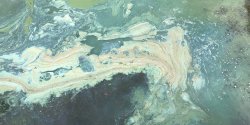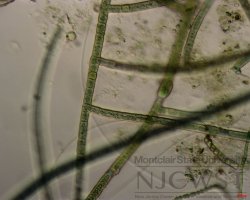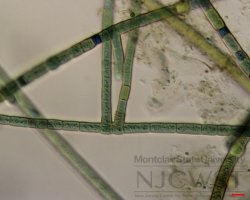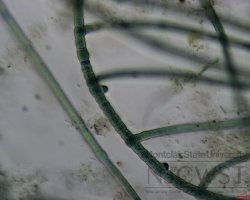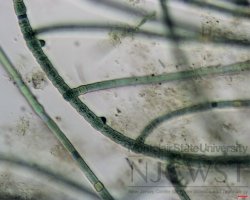Taxonomy
- Order
- Nostocales
- Family
- Hapalosiphonaceae
- Genus
- Hapalosiphon
Examples of Hapalosiphon
Morphology
Thallus thin, composed of clusters of entangled filaments; initially attached to substrate, later free-floating in metaphyton. Filaments flexuous. Thin, firm, sheaths; close or somewhat widened; sometimes indistinctly lamellated. True-branching, with branches sometimes only unilateral; branches erect from prostrate primary filament; rarely with false, scytonema-type, branching as well; branching irregular; branches usually diverge at a right angle to the main axis (forming a “T” shape). Branches and main trichome are not morphologically differentiated; branches as wide as the main filament, or sometimes just slightly narrower. Trichomes are uniseriate (only with 2 cells next to one another before branching, in old filaments); main axis of trichomes cylindrical, or somewhat moniliform (bead-like; composed of more spherically-shaped cells) in older parts; branches cylindrical. Barrel-shaped to cylindrical cells; roughly cylindrical, rounded terminal cells.
Heterocytes intercalary, only rarely lateral; usually solitary; cylindrical, quadrate or rounded-rectangular; slightly shorter than wide to isodiametric to several times longer than wide. Akinetes little known. Hormogonia usually separate from the ends of branches, and often contain aerotopes; sometimes gathered in fascicles, resembling the fasciculated colonies of Aphanizomenon (Hindák 2012).
Ecology
Mostly metaphytic in tropical and temperate regions; in stagnant waters, swamps, littoral zone of lakes and ponds; usually with aquatic plants. Some species occur in moors and peat bogs. In the United States, one species reported in thermal waters; two subaerial species reported.
References
- Hindák, František. (2012). Hormogonia in two nostocalean cyanophytes (cyanobacteria) from the genera Hapalosiphon and Fischerella. Biologia. 67(6): 1075-1079. https://doi.org/10.2478/s11756-012-0100-3
- Johansen, J. R., & Komárek, J. (2015). Filamentous Cyanobacteria. In J. D. Wehr, R. G. Sheath, & J. P. Kociolek (Eds.), Freshwater Algae of North America: Ecology and Classification (2nd ed., pp. 183-201). Waltham, MA: Elsevier.
- Komárek, J. (2013). Cyanoprokaryota-3. Teil/Part 3: Heterocytous Genera (J. R. Johansen, Ed.). In B. Büdel, G. Gärtner, L. Krienitz, & M. Schagerl (Eds.), Süßwasserflora von Mitteleuropa (Vol. 19/3, pp. 511-529). Heidelberg, Germany: Springer Spektrum.
